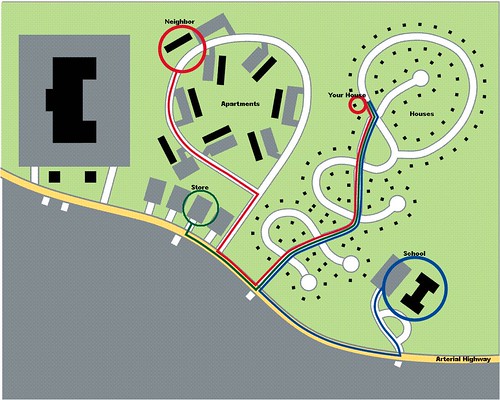Virginia adopts innovative smart streets rules

Posted March 23, 2009 at 1:17PM
Under the leadership of governor Tim Kaine, the Commonwealth of Virginia has adopted new requirements designed to make neighborhood streets more connected, walkable, and safe. In particular, the new regulations limit the number of new dead-end cul-de-sacs, require sidewalks in most new subdivisions, and encourage narrower street widths that slow traffic. Developers must meet the new criteria in order for their streets to be eligible for maintenance by the state.
Research shows that connected streets encourage walking and reduce vehicle miles traveled, associated emissions, traffic congestion, and emergency response times. Moreover, as recounted here last month, new research shows that, contrary to popular belief, neighborhoods with connected streets have fewer traffic fatalities than do subdivisions dominated by cul-de-sacs.
Here's an illustration from the Virginia Department of Transportation showing how isolated subdivisions with dead-end streets make it difficult to reach even adjacent schools and shops without driving on frequently busy arterial roads:
It shows a hypothetical route marked in red to a neighbor's home, one marked in blue to a nearby school, and one marked in green to a nearby retail establishment.
In a story reported in Sunday's Washington Post, reporter Eric M. Weiss describes a situation typical of new development in many large metro areas:
"Recently, the Census Bureau reported that the longest average commute in the country was in suburban Washington: subdivisions off Linton Hall Road in Prince William, where [a family quoted in the story] live. Many of those communities were built using the cul-de-sac template, and traffic for all purposes is fed onto Linton Hall Road. Soon, the road was jammed day and night. Because of the state's dire financial straits, the county had to pick up the cost of widening Linton Hall to four lanes.
And it is still jammed during peak times, with many trips just to get a gallon of milk or drop off children at school."
Although subdivisions with connected, gridded streets are gaining in the marketplace even without a regulatory assist, the pattern of dead-end streets has become so prevalent in new residential development that some consumers of new housing are distrustful of anything else. Particularly for families with small children - a diminishing but still significant minority of all households - there is an understandable concern that connected streets will increase vehicle traffic and reduce safety.
As noted, research suggests the opposite, and so does my personal experience with an older, traditional neighborhood. In fact, even beyond my own neighborhood, as I rode my bike this afternoon through quiet suburban neighborhoods with connected streets, there were lots of happy children playing outside on a nice spring day and almost no automobile traffic. It's largely a matter of design rather than restricted access.
For example, EPA's smart growth office had this to say about Northwest Landing (see photo),  a new development in Washington state with a connected street network:
a new development in Washington state with a connected street network:
"The design of the streets and houses also encourages walking. Streets are narrow to slow traffic and make crossing easier. Lots are narrow and deep so pedestrians pass more of their neighbors during a given walk. Front porches are the focus of house designs so walkers can visit with neighbors as they pass. Garages are placed on back alleys so cars won't hit pedestrians as they back down their driveways."
It will be critical to build these design features into new, connected neighborhoods, to make new neighborhoods as inviting and well-functioning as possible, and to help win over the portion of the market that has grown accustomed to dead end streets. For better or worse, though, there will remain plenty of cul-de-sac development in Virginia for the foreseeable future. In addition to those already built, the new rules do not ban dead ends but do restrict their number, under a technical formula that varies the allowed number according to the type of subdivision in question.
The deficiency in the market is in the smarter, more connected alternative that the Commonwealth is now promoting. They are to be commended for it.
Smart growth policy wonks, go here for the actual regulation.
